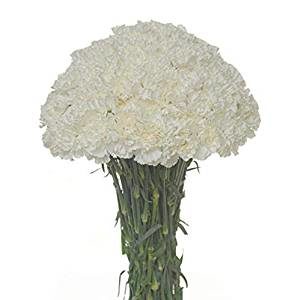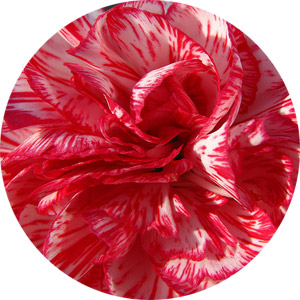January Birth Flower.
 According to a Christian legend, the carnation bloomed on that day, when Jesus was born. This flower symbolized the sufferings of Christ, that’s why the Carnation is often depicted in paintings with a portrait of the Virgin Mary and child. We can find evidence of this fact in the pictures of Leonardo DA Vinci, Raphael, and Rembrandt. Its name is also associated with the nails which were used in the crucifixion of Christ.
According to a Christian legend, the carnation bloomed on that day, when Jesus was born. This flower symbolized the sufferings of Christ, that’s why the Carnation is often depicted in paintings with a portrait of the Virgin Mary and child. We can find evidence of this fact in the pictures of Leonardo DA Vinci, Raphael, and Rembrandt. Its name is also associated with the nails which were used in the crucifixion of Christ.
Carnations have been very popular flowers in bouquets for centuries and date back as far as the Greek and Roman Times. It has been given a place of honor as being the January birth flower to represent the first month of the year brings with it its beauty and distinction.
The Meaning, Significance, And Symbolism
This flower symbolized the engagement in the pictorial art of XV-XVI centuries, when it was in the hand of a woman, while the red Carnation symbolized a pure love, the Pink Carnation pinned to the dress of the bride, that’s why the newlyweds are often depicted with carnations in their hands. Also, in Belgium, the Carnation was a symbol of the fireside.
 As one of the world’s oldest cultivated flowers, it is also said to have first grown when Mary, the mother of Jesus, wept as her son hung on the cross. The Latin origin of the word carnation is “incarnacyon” (incarnation) or “carnis” (flesh) fits in with this for its meaning of God made flesh. You only have to look at the rough translation of the scientific name, being “flower of the gods” or “flowers of love” to understand why this flower remains so popular today. It has a beautiful scent and blooms for a long period of time too.
As one of the world’s oldest cultivated flowers, it is also said to have first grown when Mary, the mother of Jesus, wept as her son hung on the cross. The Latin origin of the word carnation is “incarnacyon” (incarnation) or “carnis” (flesh) fits in with this for its meaning of God made flesh. You only have to look at the rough translation of the scientific name, being “flower of the gods” or “flowers of love” to understand why this flower remains so popular today. It has a beautiful scent and blooms for a long period of time too.
In Greek and Roman times the carnation was used in décor and art and has adorned many a flower bouquet throughout the years. Symbolically, in 1908 a white carnation was handed out at the first Mother’s Day service as a symbol of the strength and purity that goes with motherhood. The original color of the carnation is believed to have been pink or peach but as we know today, they come in an array of colors. Although the general meaning of the carnation includes love and fascination what sets this beautiful flower apart is the symbolic meaning specific to each color.
Symbolic Meaning Of Colors
The pink carnation as we know it signifies a mother’s love while the red one suggests love and affection for deep red or friendship and admiration for the lighter shades of red. A white carnation is often used at weddings as a symbol of faithfulness, innocence, amorous love and pure love while, at other times, it may be given as a symbol of good luck or gratitude. For St. Patrick’s Day a white carnation is often worn together with a dyed green carnation. Some of the other colors also have symbolism attached to them that are not as well known as the more prominent colors. One of them is the yellow carnation which symbolically means rejection or is given as a sign of disappointment. Another is the beautiful hybrid or stripped carnation that comes in an assortment of colors with the most common being white with pink stripes on the edges of the petals. It is hard to believe that such an attractive flower can symbolize refusal.
[catlist name=”january”]


